 |
SRGC Bulb Log Diary |
| Home Recommend This Site To A Friend |
|
BULB LOG 26 ----- 22nd June 2004  Rhodohypoxis troughs and pots This is a fairly typical scene in our garden with pots and troughs lying everywhere - the few alpines we still grow in pots are outside, taking the open air along with a few peonies, pots of bulbs and the Rhodohypoxis troughs.  Rhodohypoxis x4 I just love these dwarf, summer flowering South African bulbs, they are so colourful. As long as you keep them dry in the winter and give them plenty of water when they are in growth through the summer, they will reward you with a display like this for weeks. 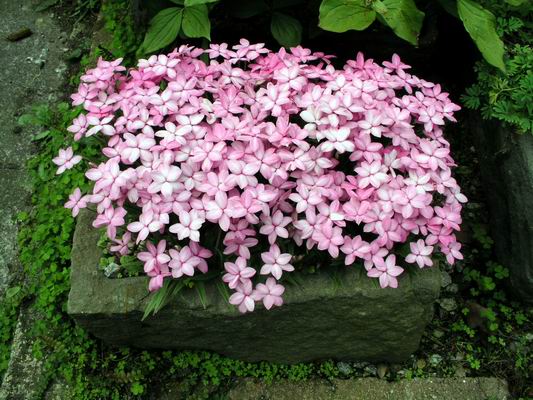 Rhodohypoxis We grow ours either in polystyrene fish box troughs or small stone ones that we can lift into the glasshouse to be dried off for the winter. 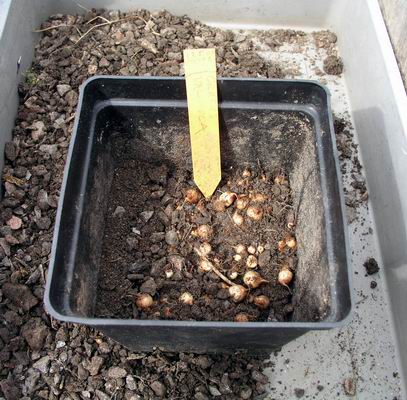 Crocus vallicola seedlings June is the time that we start the re-potting and this is the first time that this pot of Crocus vallicola seedlings has been tipped out since it germinated. What I wanted to draw your attention to is the depth that these young bulbs are at in the pot, almost the length of a standard plastic label, 10cms. I keep going on about planting your bulbs deeply and I know that many people have a fear that the tiny shoots will not be able to reach the surface form this sort of depth but this is not the case. These three and four year old seedling bulbs have put themselves down there; this is their preferred position in the pot.  Erythronium revolutum seedlings When it comes emptying out a trough of Erythronium seedlings I never have any trouble knowing where they will be. I just flip the contents out, upside down and there are the young bulbs all at the bottom, sometimes they try and go through the polystyrene bottom. 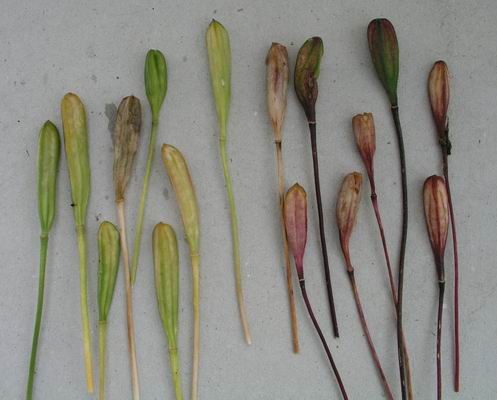 Erythronium revolutum seedpods It is also the time to be collecting the Erythronium seed and I do this by cutting the pods off the plant with a good length of the stem then I place these upside down in a paper bag in the potting shed. It is funny how we do not always see the obvious. I have been collecting our seed in this way for years and it is only now that I have paid enough attention to realise that Erythronium revolutum seedpods and stems come in two distinct colour types, green and red. I must start noting the difference and comparing that to the flower and leaf shape and colour - fascinating. 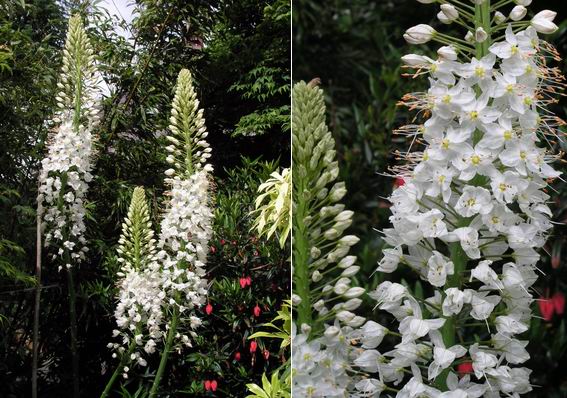 Eremurus Flowering at around 1.75meters tall this foxtail lily, Eremurus 'Johanna', is a magnificent plant in our garden. It grows from a shallow radiating root system that is best described as a fat star fish. There is a lovely picture of Eremurus spectabilis, growing in Iran, on the cover of the latest SRGC Journal ' The Rock Garden' , this is due to be distributed soon (the Journal that is, not the eremurus!). 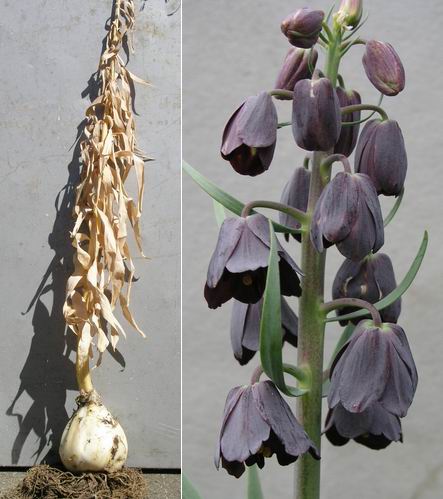 Fritillaria persica bulb While I am on about tall bulbs and Iran, here is a bulb of Fritillaria persica, one of the bigger frits, the stem is around 1 meter tall and the bulb is bigger than a clenched fist. I have included a picture of the flowers to remind you of what they are like. 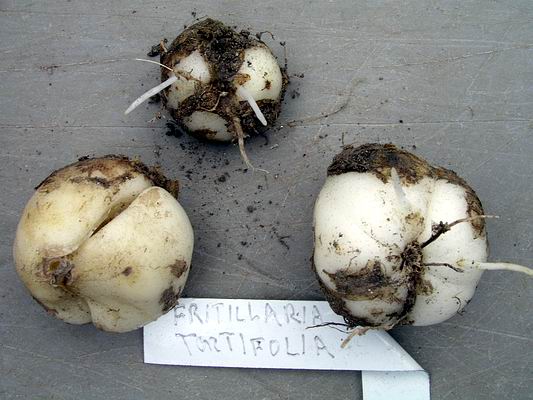 Ftritillaria tortifolia bulb Always among the first frits that we re-pot are the Chinese species. As this picture shows they want to root very much earlier than their Eurasian and the North American relatives - they are often showing the first roots emerging in June. We re-pot them into damp compost and either keep the pots outside to take the rain or, if they are under glass, apply an occasional watering through July and August to ensure they do not dry out completely, (they get the same regime as the others from September on). 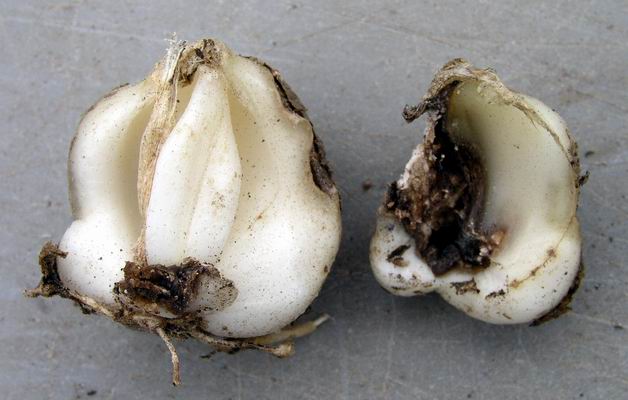 Chinese frit bulb This picture shows very clearly the simple twin scale type of fritillaria bulb. On the left is the main scale with next years growth shoot clearly visible and just to the left of it you can see the dried remains of this years stem. Unfortunately I have had to remove the other scale as it is partially rotten and I did not want this to infect the healthy scale. The bulb will flower perfectly well next year on the single scale. After I cut away all the soft and rotten material on the scale to the right, I will place it into dry sand in a small plastic bag then keep it in the fridge and there is a very good chance that it will form some nice new bulbils so not all is lost. 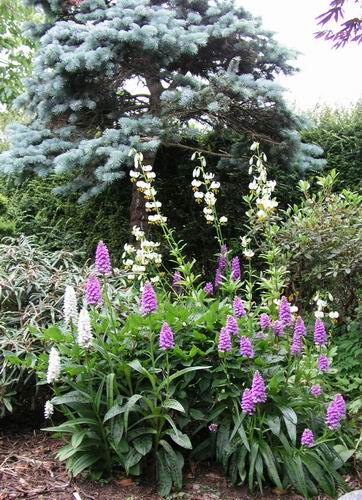 Orchids and lilies Another scene in the garden showing Lilium martagon album and Dactylorhizas which are at their best just now. To the front left you will see the rare and beautiful white form Dactylorhiza 'Eskimo Nell' 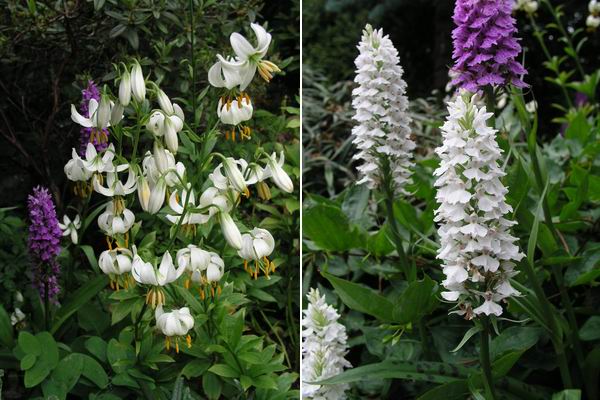 Lilium martagon & Dactylorhiza 'Eskimo Nell' ^ back to the top ^ |